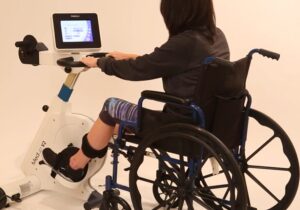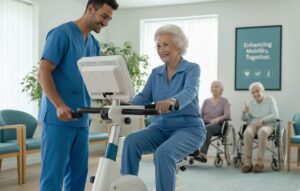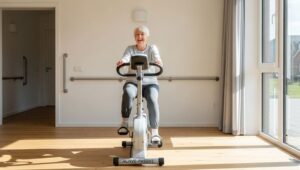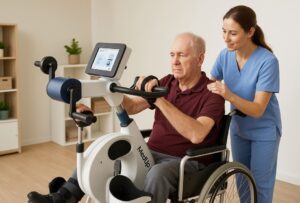
Rehabilitation and physiotherapy have witnessed a remarkable transformation with the integration of wheelchair-accessible motor-assisted bikes. These innovative solutions play a pivotal role in improving the well-being of individuals facing mobility challenges.
Motor-assisted bikes offer a wide range of benefits for healthcare facilities, including rehabilitation centers and physiotherapy clinics. Advanced bikes incorporate ergometers, providing specific advantages, including their ability to detect and release muscle spasms, decrease spasticity, stimulate blood flow, and much more.

Rehabilitation and Physiotherapy Benefits of Wheelchair-Accessible Motor-Assisted Bikes:
- Muscle Spasm Management:
- Wheelchair-accessible motor-assisted bikes are designed to detect and release muscle spasms effectively. This feature is especially valuable for patients undergoing rehabilitation. By engaging in controlled, low-resistance pedaling, individuals can promote blood circulation and alleviate muscle tension, contributing to a more comfortable and productive rehabilitation process.
- Spasticity Reduction:
- These bikes play a crucial role in reducing spasticity, a common challenge for individuals with mobility issues. The gentle, continuous motion provided by motor-assisted bikes helps relax stiff or tight muscles and joints, allowing patients to experience a greater range of motion.
- Stimulating Blood Flow:
- The motion and exercise facilitated by these bikes stimulate blood flow throughout the body. Improved circulation is essential for the overall health and well-being of patients, reducing the risk of complications such as blood clots.
- Edema Management:
- For individuals struggling with edemas or swelling, motor-assisted bikes offer a non-invasive method to manage and reduce these issues. By promoting fluid movement and circulation, these bikes contribute to enhanced comfort and a reduction in edema-related discomfort.
- Enhanced Joint Mobility:
- One of the key benefits for patients in rehabilitation or physiotherapy is the improvement of joint mobility. Wheelchair-accessible motor-assisted bikes assist patients in gradually regaining flexibility and range of motion in both upper and lower extremities.
- Facilitating Motor Recovery:
- These bikes play an instrumental role in motor recovery. Whether due to injuries, chronic conditions, or accidents, they help patients regain control and function in limbs affected by physical limitations.
- Improving Coordination and Muscle Strength, Including Core Strength:
- The controlled, adjustable resistance levels provided by motor-assisted bikes assist patients in building muscle strength, including core muscles. Enhanced coordination and core strength are essential components of rehabilitation and physiotherapy, supporting better posture, stability, and overall function.
- Maintaining or Improving Function:
- For individuals with chronic conditions, the use of motor-assisted bikes can help maintain and, in some cases, improve function over time. This is particularly valuable for those seeking to enhance their independence and overall quality of life.
Rehabilitation Therapy for Positive Patient Outcomes
Wheelchair-accessible motor-assisted bikes have revolutionized rehabilitation and physiotherapy practices in healthcare facilities, including rehabilitation centers and physiotherapy clinics. These versatile devices offer a myriad of benefits that cater to patients with mobility challenges. By addressing issues like muscle spasms, spasticity, blood flow stimulation, edema management, joint mobility, and overall well-being, they are reshaping the way healthcare professionals approach patient care. Whether you’re a rehabilitation specialist, a physiotherapist, or an individual on a journey to recovery, these motor-assisted bikes have the potential to be a game-changer, offering a path to improved health, mobility, and independence.




